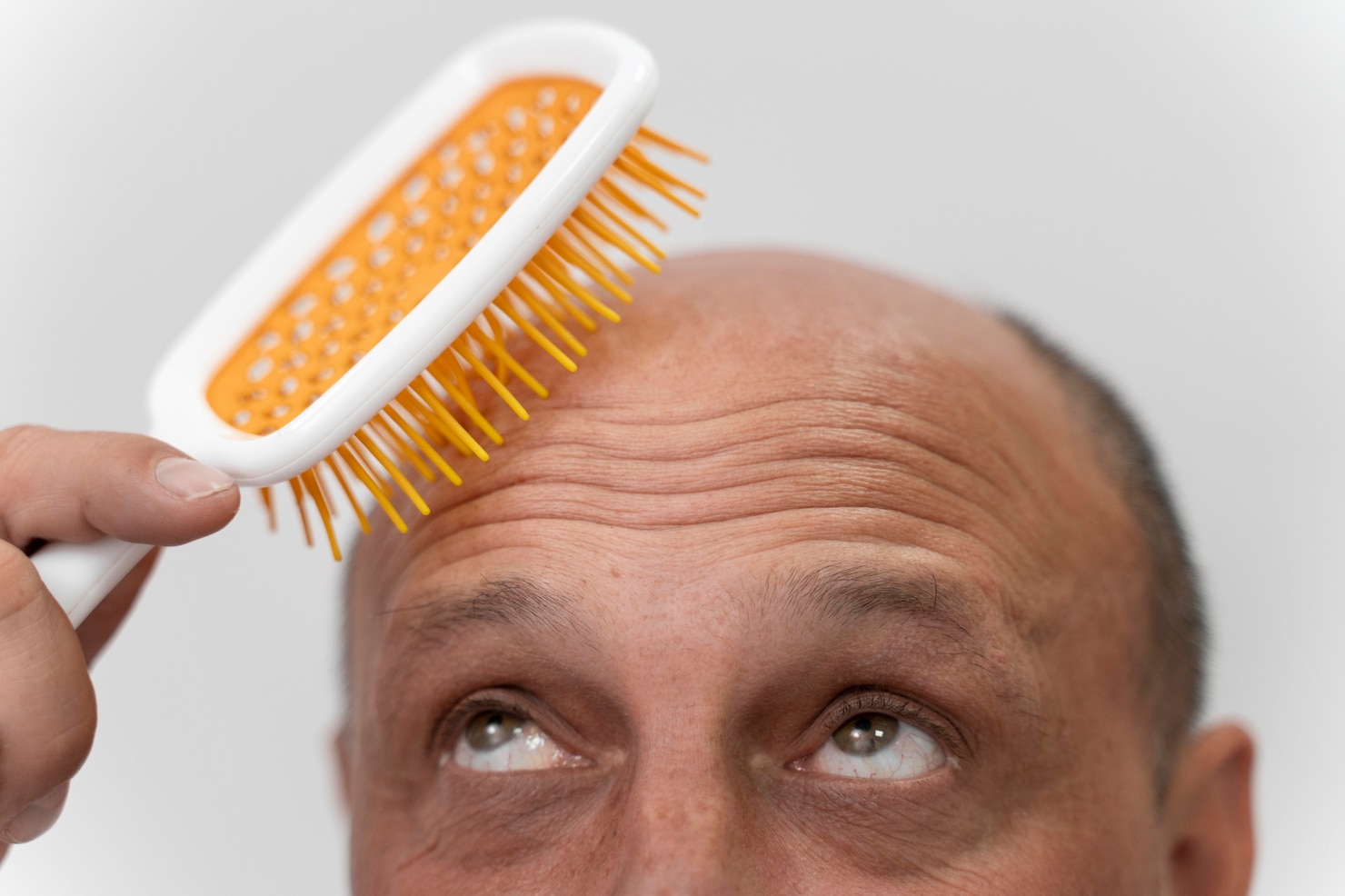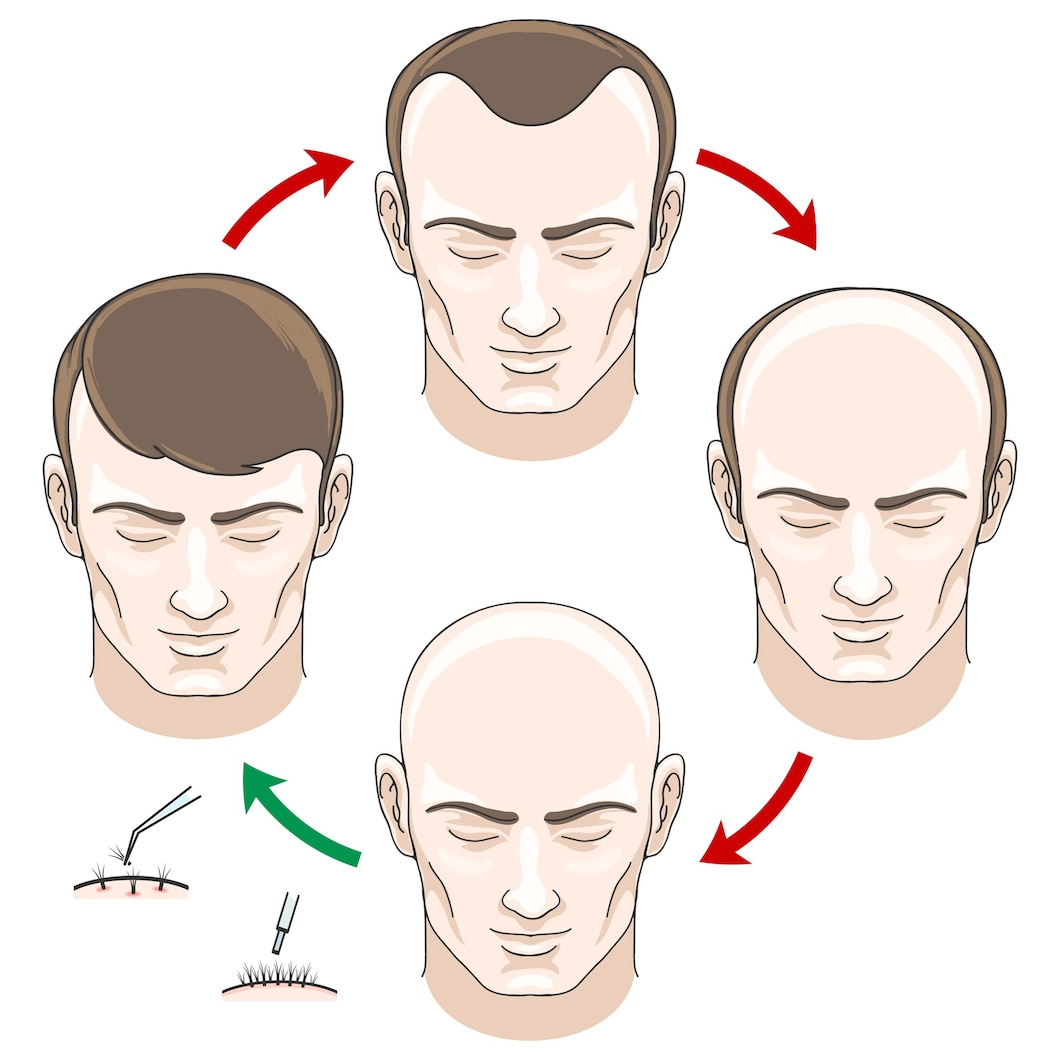
Hair loss is a common concern for men, and a receding hairline is often the first noticeable sign. This blog post delves into the signs of receding hairline, covering topics such as how to tell if your hairline is receding and what is a receding hairline. The science behind the issue is discussed, highlighting the role of genetics and hormonal factors so you don’t have to keep getting confused between a widows peak vs receding hairline.
Hair care tips are provided, emphasizing a gentle routine and suitable styling techniques. The post also suggests products to consider, such as hair loss shampoos and hair thickening products. Common questions about reversing a receding hairline and natural remedies are addressed, providing scientific knowledge for informed decision-making.
Signs of Receding Hairline
Thinning Hair at the Temples
One of the prominent signs of receding hairline is the thinning of hair at the temples. You may notice that the hair around your temples becomes noticeably sparse, creating a less dense appearance. Over time, this thinning can progress, making the receding hairline more apparent. Thinning hair at the temples is often one of the initial indicators that you may be experiencing a receding hairline.
Formation of an "M" or "U" Shape Hairline
Another telltale sign of a receding hairline is the formation of an "M" or "U" shape at the front of the scalp. As hairline recession occurs, the hairline starts to retract from its original position, resulting in the formation of these distinctive shapes. The "M" shape refers to the corners of the hairline receding, resembling the letter "M." On the other hand, the "U" shape refers to a more uniform recession, with the entire hairline moving backward, forming a gentle curve resembling the letter "U."
These signs and symptoms of a receding hairline can vary in severity and progression among individuals. It is essential to be vigilant and observe any changes in your hairline over time. Monitoring the thinning hair at the temples and the formation of an "M" or "U" shape hairline can help you recognize and address a receding hairline at its early stages.
Key Takeaway:
Thinning hair at the temples and the formation of an "M" or "U" shape hairline are common signs and symptoms of a receding hairline. Paying attention to these indicators can help you identify and take necessary measures to address hair loss concerns.Understanding the Science Behind Receding Hairline

Image Source: FreePik
The Role of Genetics in Hair Loss
Genetics plays a significant role in the development of a receding hairline. Research has shown that certain genes inherited from your parents can make you more susceptible to hair loss, including the recession of the hairline.
The most common genetic factor involved in male pattern baldness, which often manifests as a receding hairline, is the androgen receptor gene. This gene influences the sensitivity of hair follicles to dihydrotestosterone (DHT), a hormone derived from testosterone. When hair follicles are genetically sensitive to DHT, they shrink over time, leading to progressively shorter and thinner hair until they no longer produce visible hair strands.
Hormonal Factors Contributing to Receding Hairline
Apart from genetics, hormonal factors also contribute to the development of a receding hairline. In particular, the hormone DHT mentioned earlier plays a key role. Testosterone, a hormone naturally produced in the body, is converted into DHT by the enzyme 5-alpha-reductase.
DHT binds to receptors in the scalp, triggering a process called miniaturization. This process causes hair follicles to become smaller and produce finer, weaker hair, eventually leading to their complete shutdown.
Key Takeaway:
Genetics and hormonal factors, such as the role of the androgen receptor gene and the hormone DHT, contribute significantly to the development of a receding hairline. Understanding these scientific factors empowers you to take proactive steps in managing hair loss concerns effectively.Hair Care Tips for Men with Receding Hairline
Gentle Hair Care Routine
When dealing with a receding hairline, adopting a gentle hair care routine is essential to maintain the health of your remaining hair. Start by using a mild shampoo that is suitable for your hair type and scalp condition. Avoid harsh ingredients, such as sulfates, that can strip the hair of its natural oils and cause further dryness. Instead, look for shampoos that contain nourishing ingredients like biotin, panthenol, and natural oils to promote hair strength and vitality.
Additionally, be mindful of how you handle and style your hair. Avoid vigorous towel-drying or rough brushing, as it can lead to hair breakage and further damage. Instead, gently pat your hair dry with a soft towel and use a wide-toothed comb or a brush with soft bristles to detangle and style your hair.
Styling Techniques for Receding Hairline
Choosing the right hairstyle and employing suitable styling techniques can help minimize the appearance of a receding hairline. Consider opting for shorter hairstyles, as they can create an illusion of thickness and fullness. Shorter haircuts also draw less attention to the hairline and provide a more balanced look.
Another styling technique to consider is adding volume and texture to your hair. This can be achieved by using styling products specifically designed for adding thickness and lift, such as volumizing sprays or powders. Apply these products to the roots of your hair and use your fingers to gently tousle and create texture for a fuller appearance.
Key Takeaway:
Adopting a gentle hair care routine and employing suitable styling techniques are crucial for men with a receding hairline. By using mild shampoos, handling hair with care, and opting for appropriate hairstyles and products, you can maintain the health of your hair and enhance its appearance, minimizing the visibility of a receding hairline.Products to Consider for Receding Hairline

Image Source: FreePik
Hair Loss Shampoos Containing Ingredients like Minoxidil or Ketoconazole
When it comes to addressing a receding hairline, certain hair loss shampoos can be beneficial. Look for shampoos that contain key ingredients like minoxidil or ketoconazole. Minoxidil is an FDA-approved ingredient that has been shown to promote hair regrowth and slow down hair loss. It works by stimulating blood flow to the hair follicles, revitalizing them and potentially promoting the growth of thicker, healthier hair.
Ketoconazole, on the other hand, is an antifungal ingredient that can help reduce scalp inflammation and combat dandruff. It has also been found to have potential anti-androgenic effects, which may contribute to its effectiveness in treating hair loss.
Hair Thickening and Volumizing Products with Ingredients like Biotin and Collagen
To enhance the appearance of a receding hairline, consider incorporating hair thickening and volumizing products into your routine. Look for products that contain ingredients like biotin and collagen. Biotin is a B vitamin that supports hair health and may help strengthen hair strands, making them appear thicker and more resilient. Collagen, on the other hand, can provide structural support to the hair, giving it added thickness and volume.
Additionally, you may want to explore styling products like volumizing sprays or mousses that can temporarily add fullness and lift to your hair. These products often contain polymers or resins that coat the hair shaft, creating a thicker appearance and providing extra hold for your desired hairstyle.
When selecting products for your receding hairline, keep in mind that individual results may vary, and it's important to be consistent with their use to see potential benefits. Consider consulting with a dermatologist or trichologist who can provide personalized recommendations based on your specific needs.
Key Takeaway:
Hair loss shampoos containing ingredients like minoxidil or ketoconazole can help address hair loss associated with a receding hairline. Additionally, using hair thickening and volumizing products with biotin and collagen can enhance the appearance of your hair, making it appear thicker and fuller. Remember to consult with a professional for personalized product recommendations and to maintain consistency for potential benefits.Frequently Asked Questions about Receding Hairline
Can a Receding Hairline Be Reversed?
While it is challenging to completely reverse a receding hairline, there are treatments and interventions available that can help slow down hair loss and promote hair regrowth. Options such as medications, topical solutions, and hair transplant surgeries may be recommended by dermatologists or hair restoration specialists.
Minoxidil and finasteride are commonly used medications that have shown positive results in some individuals by stimulating hair growth and preventing further hair loss. However, it is important to note that the effectiveness of these treatments can vary from person to person, and results may take time to become noticeable.
Are There Any Natural Remedies for Receding Hairline?
While natural remedies may not provide a guaranteed solution for reversing a receding hairline, some individuals find certain practices beneficial in supporting overall hair health.
Maintaining a balanced diet rich in vitamins, minerals, and proteins can provide essential nutrients for hair growth. Additionally, practices like scalp massages, using essential oils like rosemary or lavender, and reducing stress levels may contribute to a healthier scalp and potentially improve the condition of the hair.
However, it is important to remember that natural remedies may not have the same level of scientific evidence or effectiveness as medically-proven treatments.
Conclusion
Recognizing the signs of a receding hairline, understanding the scientific factors behind it, adopting a gentle hair care routine, and considering suitable products and treatments are essential for effective management. Consultation with professionals is recommended for personalized guidance.

